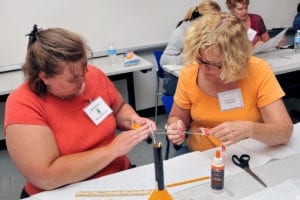3 Tips to Empower Parents with Research and Resources
From preventing summer learning loss to promoting engagement in STEM, there is abundant research that show parents play an important role in their children’s academic and career paths. And yet how can every parent access research and resources to help their children? We highlight three organizations that have found creative ways to support parents. Our take-away from these organizations and their innovative approaches is twofold. First, they listen to parents’ priorities. Second, they strive to make research and resources truly accessible to families.
1. Make resources and programs accessible to parents. Think outside the box (and the place).

EdNavigator
For many parents, barriers to participation in programs are practical. Not having transportation, being unable to arrange for child care, and having work and scheduling conflicts are challenges that keep parents from participating in programs. New Orlean’s EdNavigator listened to parents and responded. EdNavigator hacked the usual barriers and flipped its model for parent engagement. Instead of requiring parents to come to them, they go to parents where they work. Advisers — called Navigators—go to the workplace and support parents with academic guidance for their children from preschool through college. They share research and practical strategies with parents. For example, they highlight summer learning loss and offer accessible ideas like free summer reading programs at the library, free apps like Bedtime Math, and online coding lessons from Code.org. While not STEM-focused, EdNavigator presents an innovative way of rethinking parent engagement that we can apply to our STEM work.
2. Make research accessible and then some.

Once you’ve listened to parents and made your programs accessible, be ready to support them in supporting their child’s STEM learning. Like EdNavigator, Techbridge Girls also communicates to parents the importance of summer learning. Staff put together a list of summer options in STEM that are girl-friendly and affordable. They talk up these programs with girls in afterschool programs and with parents at family nights. Techbridge Girls learned that it wasn’t enough to just tell families about programs. For some families, additional help was needed. So, staff held family workshops where they supported girls and parents with their online applications to STEM summer programs.
3. Build parents’ confidence with knowledge.

In a survey about science education commissioned by Bayer, nearly one-third (31%) of parents don’t feel confident enough in their scientific knowledge to help their children engage in hands-on science activities. The National PTA is working to change that. In partnership with founding sponsors, Bayer and Mathnasium, the PTA launched STEM + Families. Dr. Renee LaHuffman-Jackson, co-author of the PTA white paper, notes that for change in STEM to be effective, family engagement has to take place systemically in homes and communities, and not through a one-time event at school. This requires a broad shift in mindset with how schools and afterschool programs approach family engagement in STEM. “The most important thing that we can do is help parents see the potential and opportunities for their children in STEM careers, and do this by having people who look like them tell their own story in STEM.” Demystifying STEM and STEM careers empowers families – even those without a STEM background – to support and encourage their children in STEM both in and out of school.

